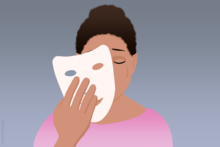Masking (personality)

In psychology and sociology, masking, also known as social camouflaging, is a defensive behavior in which an individual conceals their natural personality or behavior in response to social pressure, abuse, or harassment. Masking can be strongly influenced by environmental factors such as authoritarian parents, social rejection, and emotional, physical, or sexual abuse. Masking can be a behavior individuals adopt subconsciously as coping mechanisms or a trauma response, or it can be a conscious behavior an individual adopts to fit in within perceived societal norms. Masking is interconnected with maintaining performative behavior within social structures and cultures.[1]
History
[edit]
Masking has existed since antiquity, with authors like Shakespeare referencing it in fiction long before masking was formally defined and studied within psychology.[2] Frantz Fanon is credited with defining masking in his 1957 Black Skin, White Masks, which describes masking behavior in race relations within the stratified post-war United States.[1][3] Fanon explains how African-Americans, especially those of low social capital, adopted certain behaviors to resemble white people as well as other behaviors intended to please whites and reinforce the white man's higher social status.[3]
The black man has two dimensions. One with his fellows, the other with the white man. That this self-division is a direct result of colonialist subjugation is beyond question.
— Frantz Fanon, Black Skins, White Masks, [3]
The term masking was used to describe the act of concealing disgust by Paul Ekman (1972) and Friesen (1969).[4] It was also thought of as a learned behavior. Developmental studies have shown that this ability begins as early as preschool and improves with age.[5] Masking is mostly used to conceal a negative emotion (usually sadness, frustration, and anger) with a positive emotion or indifferent affect.[4]
Causes
[edit]The social drivers of masking include social discrimination, cultural dominance, and violence. Elizabeth Radulski argues that masking is a cultural performance within Judith Butler's concept of performativity that helps individuals bypass cultural and structural barriers.[1]
Situational contexts
[edit]The causes of masking are highly contextual and situational. Masking may disguise emotions considered socially inappropriate within a situational context, such as anger, jealousy, or rage. Individuals may mask in certain social situations, such as job interviews or dates, or around people of different cultures, identities, or ethnicities.[4] Since different social situations require different performances, individuals often switch masks and exhibit different masking behaviors in different contexts. Code-switching, although associated more with linguistics, also refers to the process of changing one's masking behavior around different cultures in social and cultural anthropology.[6] Contextual factors including relationships with one's conversation partner, social capital (class) differences, location, and social setting are all reasons why an individual would express, suppress, or mask an emotion.[7]
There is a gendered disparity in masking behavior; studies show women mask negative emotions to a greater extent than men. According to psychologist Teresa Davis, this may be due to the greater social expectation for conformity placed on female gender roles, causing women to develop the skill to a greater extent than men during childhood socialization.[8]
Autistic masking
[edit]Autistic masking, also referred to as camouflaging, is the conscious or subconscious suppression of autistic behaviors or the compensation of difficulties in social interaction by autistic people with the goal of being perceived as neurotypical.[9][10] It is a learned coping strategy.[11][12]
Typical examples of autistic masking include the suppression of stimming and meltdowns, a common reaction to sensory overload.[11] To compensate difficulties in social interaction with neurotypical peers, autistic people might maintain eye contact despite discomfort, use rehearsed conversational scripts, or mirror the body language and tone of others.[9][10][11][13]
Masking requires an exceptional effort.[11][14] It is linked with adverse mental health outcomes such as stress,[15] autistic burnout,[10] anxiety and other psychological disorders,[15] loss of identity,[15] and suicidality.[10][15][16] Some studies find that compensation strategies are seen as contributing to leading a successful and satisfactory life.[9][17]
Gender Differences
[edit]Research suggests that there are noticeable differences in social camouflaging between males and females, with the claim that females are more prevalent in masking their personalities in social situations more than men. Due to the autism gender gap, the scenario in which autism within females is not as recognized as it is in males,[18] females often times have a harder time getting a diagnosis of autism at an earlier age, bringing a more pressured conforming to social cues and reciprocity to social situations, leading to higher cases of female autistic individuals masking more often. Not only this, but due to females with ASD (Autism Spectrum Disorder) learning to mask at such early stages of life, many females will remain undiagnosed, or get a late diagnosis of autism. [19]
Environment also plays a role in autistic females learning how to mask themselves more than male autistic individuals. Females with ASD have a higher tendency to learn through a series of mimicking others, this would lead ultimately lead to females with ASD learning how to mask as if it was second nature. [20]
Consequences
[edit]Little is known about the effects of masking one's negative emotions. In the workplace, masking leads to feelings of dissonance, insincerity, job dissatisfaction, emotional and physical exhaustion, and self-reported health problems.[21] Some have also reported experiencing somatic symptoms and harmful physiological and cognitive effects as a consequence.[4]
Masking bring reports of loneliness from autistic individuals, due to the fact that many are having to suppress their true identity to conform to social standards. Masking can make it difficult to form real connections with other people, followed by statements that many feel as if they have lost their true identity as an autistic individual, feeling as if they are only playing a role for the majority of their lives. [22]
Though there are many disadvantages to masking for individuals, many report the benefits masking has brought for them. Such reports stated that individuals felt as if became easier to socialize, to uphold careers, build relationships, and even at times, were able to protect themselves. [23]
See also
[edit]- Alter ego
- Beard (companion)
- Closet Jew
- Closeted
- Defense mechanism
- Dramaturgy (sociology)
- Facial Action Coding System
- Identity formation
- Minority stress
- Model minority
- Passing (sociology)
- Persona (psychology)
- Shibboleth
- Stigma management
- Undercover
References
[edit]- ^ a b c Radulski, Elizabeth M. (2022). "Conceptualising Autistic Masking, Camouflaging, and Neurotypical Privilege: Towards a Minority Group Model of Neurodiversity". Human Development. 66 (2): 113–127. doi:10.1159/000524122. ISSN 0018-716X. S2CID 248864273.
- ^ Rippy, Marguerite Hailey, "All Our Othellos: Black Monsters and White Masks on the American Screen," Spectacular Shakespeare: Critical Theory and Popular Cinema (2002). Google Books. Accessed 3 Oct. 2022.
- ^ a b c Fanon, Frantz (1967). Black Skin, White Masks. New York: Grove Press. pp. 45–52. ISBN 0802150845.
- ^ a b c d De Gere, Dawn (2008). "The face of masking: Examining central tendencies and between-person variability in display management and display rule". ProQuest Dissertations and Theses.
- ^ Cole, Pamela (Dec 1986). "Children's Spontaneous Control of Facial Expression". Child Development. 57 (6): 1309–1321. doi:10.1111/j.1467-8624.1986.tb00459.x.
- ^ Pountney, Laura & Marić, Tomislav (2015). Introducing Anthropology: What Makes Us Human? (1st ed.). Wiley. ISBN 9780745699783.
{{cite book}}: CS1 maint: multiple names: authors list (link) - ^ Malchiodi, Cathy. "The Healing Arts". Psychology Today.
- ^ Davis, Teresa (1995). "Gender Differences in Masking Negative Emotions: Ability or Motivation?". Developmental Psychology. 31 (4): 660–667. doi:10.1037/0012-1649.31.4.660.
- ^ a b c Petrolini, Valentina; Rodríguez-Armendariz, Ekaine; Vicente, Agustín (2023). "Autistic camouflaging across the spectrum". New Ideas in Psychology. 68: 100992. doi:10.1016/j.newideapsych.2022.100992. hdl:10810/59712. S2CID 253316582.
- ^ a b c d Pearson, Amy; Rose, Kieran (2021). "A Conceptual Analysis of Autistic Masking: Understanding the Narrative of Stigma and the Illusion of Choice". Autism in Adulthood. 3 (1): 52–60. doi:10.1089/aut.2020.0043. PMC 8992880. PMID 36601266.
- ^ a b c d Hull, Laura; Petrides, K. V.; Allison, Carrie; Smith, Paula; Baron-Cohen, Simon; Lai, Meng-Chuan; Mandy, William (2017). ""Putting on My Best Normal": Social Camouflaging in Adults with Autism Spectrum Conditions". Journal of Autism and Developmental Disorders. 47 (8): 2519–2534. doi:10.1007/s10803-017-3166-5. PMC 5509825. PMID 28527095.
- ^ Lawson, Wenn B. (2020). "Adaptive Morphing and Coping with Social Threat in Autism: An Autistic Perspective". Journal of Intellectual Disability - Diagnosis and Treatment. 8 (3): 519–526. doi:10.6000/2292-2598.2020.08.03.29. S2CID 224896658.
- ^ Hull, Laura; Petrides, K. V.; Mandy, William (2020-12-01). "The Female Autism Phenotype and Camouflaging: a Narrative Review". Review Journal of Autism and Developmental Disorders. 7 (4): 306–317. doi:10.1007/s40489-020-00197-9. S2CID 256402443.
- ^ "6A02 Autism spectrum disorder". ICD-11 for Mortality and Morbidity Statistics. Retrieved 2023-05-05.
Some individuals with Autism Spectrum Disorder are capable of functioning adequately by making an exceptional effort to compensate for their symptoms during childhood, adolescence or adulthood. Such sustained effort, which may be more typical of affected females, can have a deleterious impact on mental health and well-being.
- ^ a b c d Radulski, Elizabeth M. (2022). "Conceptualising Autistic Masking, Camouflaging, and Neurotypical Privilege: Towards a Minority Group Model of Neurodiversity". Human Development. 66 (2): 113–127. doi:10.1159/000524122. S2CID 248864273.
- ^ Cassidy, Sarah; Bradley, Louise; Shaw, Rebecca; Baron-Cohen, Simon (2018). "Risk markers for suicidality in autistic adults". Molecular Autism. 9 (1): 42. doi:10.1186/s13229-018-0226-4. PMC 6069847. PMID 30083306.
- ^ Livingston, Lucy Anne; Shah, Punit; Happé, Francesca (2019). "Compensatory strategies below the behavioural surface in autism: a qualitative study". The Lancet Psychiatry. 6 (9): 766–777. doi:10.1016/s2215-0366(19)30224-x. PMC 6706698. PMID 31350208.
- ^ "Autism Gender Gap – The Autism History Project". blogs.uoregon.edu. Retrieved 2024-07-27.
- ^ Tubío-Fungueiriño, María; Cruz, Sara; Sampaio, Adriana; Carracedo, Angel; Fernández-Prieto, Montse (2021-07-01). "Social Camouflaging in Females with Autism Spectrum Disorder: A Systematic Review". Journal of Autism and Developmental Disorders. 51 (7): 2190–2199. doi:10.1007/s10803-020-04695-x. ISSN 1573-3432.
- ^ Tubío-Fungueiriño, María; Cruz, Sara; Sampaio, Adriana; Carracedo, Angel; Fernández-Prieto, Montse (2021-07-01). "Social Camouflaging in Females with Autism Spectrum Disorder: A Systematic Review". Journal of Autism and Developmental Disorders. 51 (7): 2190–2199. doi:10.1007/s10803-020-04695-x. ISSN 1573-3432.
- ^ Fisher, Cynthia; Neal Ashkanasy (2000). "The Emerging Role of Emotions in Work Life: An introduction" (PDF). Journal of Organizational Behavior. 21 (2): 123–129. doi:10.1002/(SICI)1099-1379(200003)21:2<123::AID-JOB33>3.0.CO;2-8.
- ^ "The costs of camouflaging autism". The Transmitter: Neuroscience News and Perspectives. 2018-02-21. doi:10.53053/znsg1811. Retrieved 2024-06-30.
- ^ Bradley, Louise; Shaw, Rebecca; Baron-Cohen, Simon; Cassidy, Sarah (2021-12-01). "Autistic Adults' Experiences of Camouflaging and Its Perceived Impact on Mental Health". Autism in Adulthood. 3 (4): 320–329. doi:10.1089/aut.2020.0071. ISSN 2573-9581. PMC 8992917. PMID 36601637.
Further reading
[edit]- Hall, Karyn (2012). "Wearing Masks". Psych Central. Retrieved March 1, 2018.
- Hanson, Rick (March 17, 2011). "Who Is Behind the Mask". Psychology Today. Retrieved March 1, 2018.
- Sparks, Susan (Oct 20, 2015). "The Masks That We Wear". Psychology Today. Retrieved March 1, 2018.
- Andrews, Victoria; et al. (2011). "No Evidence for Subliminal Affective Priming with Emotional Facial Expression Primes". Motivation and Emotion. 35 (1): 33–43. doi:10.1007/s11031-010-9196-3. S2CID 142863112.
- Underwood, Marion K. (1997). "Peer Social Status and Children's Understanding of the Expression and Control of Positive and Negative Emotions". Merrill - Palmer Quarterly. 43 (4): 610–34. ProQuest 1428979275.
- Hemmesch, Amanda R. (2011). "The Stigmatizing Effects of Facial Masking and Abnormal Bodily Movement on Older Adults' First Impressions of Individuals with Parkinson's Disease". Brandeis University. ProQuest 1428979275.
- Sedgewick, Felicity; Hull, Laura; Ellis, Helen (2021). Autism and Masking: How and Why People Do It, and the Impact It Can Have. London: Jessica Kingsley Publishers. ISBN 978-1-78775-580-2. OCLC 1287133295.
{{cite book}}: CS1 maint: date and year (link) - Price, Devon (2022). Unmasking Autism: The Power of Embracing Our Hidden Neurodiversity. London: Monoray. ISBN 978-1-80096-054-1. OCLC 1321047301.
- Petrolini, Valentina; Rodríguez-Armendariz, Ekaine; Vicente, Agustín (2023). "Autistic camouflaging across the spectrum". New Ideas in Psychology. 68: 100992. doi:10.1016/j.newideapsych.2022.100992. hdl:10810/59712. S2CID 253316582.
